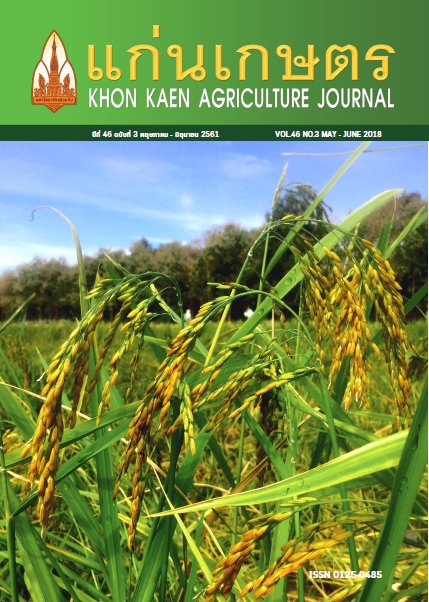ผลของการปลูกข้าวโพดแซมถั่วต่อการชะล้างพังทะลายหน้าดิน และความหลากหลายทางชีวภาพในดิน
Main Article Content
บทคัดย่อ
การปลูกข้าวโพดโดยการตัดถางและเผาทำลายเศษเหลือทิ้งที่คลุมดิน เป็นการทำลายอินทรียวัตถุซึ่งอนุรักษ์และบำรุงดิน อีกทั้งมีส่วนในการเพิ่มปัญหาหมอกควันในฤดูแล้ง การวิจัยนี้มีวัตถุประสงค์เพื่อประเมินผลการทดแทนการเตรียมดินโดยการถางและเผา ด้วยการปลูกข้าวโพดแซมถั่ว ต่อความหลากหลายของสิ่งมีชีวิตในดิน การชะล้างพังทะลายของหน้าดิน และการสูญเสียธาตุอาหาร การทดลองที่ 1 เปรียบเทียบจำนวนสิ่งมีชีวิตในดินในระบบการปลูกข้าวโพดแซมถั่วแปะยี ถั่วนิ้วนางแดง ถั่วดำ หรือถั่วเขียว กับข้าวโพดปลูกแบบเผาซาก ที่สถานีเกษตรหลวงปางดะ อำเภอสะเมิง จังหวัดเชียงใหม่ การทดลองที่ 2 เปรียบเทียบการสูญเสียหน้าดินและไนโตรเจนในข้าวโพดแซมถั่วแปะยี กับการปลูกข้าวโพดแบบเผา และไม่เผาซาก หมู่บ้านนาเลา ตำบลโป่งคำ อำเภอสันติสุข จังหวัดน่าน ในระหว่าง พ.ศ. 2556 - 2558 พบว่าสัตว์ในดินในระบบข้าวโพดแซมถั่วมีดัชนีความหลากหลายสูงกว่า มีจำนวนตัวของสัตว์สูงเป็น 3 – 4 เท่า ของในข้าวโพดเผาซาก ข้าวโพดในระบบพืชแซมยังมีจำนวนชนิดของสัตว์และจำนวนสปอร์ของเชื้ออาร์บัสคูล่าร์ไมโคไรซ่ามากกว่าด้วย ในการปลูกข้าวโพดเผาซาก มีการสูญเสียหน้าดิน 12.4 ตัน/ไร่ ในปีที่ 1 และ 8.4 ตัน/ไร่ ในปีที่ 2 ของการทดลอง ในปีที่ 1 การไม่เผาทั้งที่มีถั่วแซมและไม่มี ส่งผลในการลดการสูญเสียหน้าดินลง 57% ในปีที่ 2 การปลูกข้าวโพดแซมถั่วแปะยี ลดการสูญเสียหน้าดินลง 86% ในขณะที่ข้าวโพดแบบไม่เผาลดการสูญเสียหน้าดินลง 61% การไม่เผาซากและการปลูกข้าวโพดแซมถั่วยังลดการสูญเสียธาตุอาหารด้วย การศึกษานี ้แสดงให้เห็นถึงผลดีจากการปลูกข้าวโพดแซมถั่วและไม่เผาเตรียมพื้นที่ปลูก ในการอนุรักษ์บำรุงดิน และสร้างความยั่งยืนในการปลูกข้าวโพดบนพื้นที่สูงได้
Article Details
เอกสารอ้างอิง
Boonlertnirun, K., and C. Jompuk. 2011. Nitrogen use Efficiency and Low Nitrogen Tolerance in Waxy Corn Khon Kaen Agriculture Journal. 39: 231-240.
Brundrett, M., N. Bougher, B. Dell, T. Grove, and N. Malajczuk. 1995. Working with mycorrhizas in forestry and agriculture. 347 pp.
Brussaard, L., P. C. Ruiter, and G. G. Brown. 2007. Soil biodiversity for agricultural sustainability. Agriculture, Ecosystems and Environment. 121: 233–244.
Gardi, C. and S. Jeffery. 2009. Soil Biodiversity. European Commission Joint Research Center Institute for Environment and Sustainability Land Management and Natural Hazard Unit, Italy.Giller, K.E., M.H. Beare, P. Lavell, Izac, and M.J. Swift. 1997. Agricultural Intensification, Soil Biodiversity and Agro Ecosystem Function. Applied Soil Ecology. 6: 3-16.
Giardina, C. P., R. L. Sanford, I. C. Dochersmith, and V. Jaramillo. 2000. The effect of slash burning on ecosystem nutrients during the land preparation phase of shifting cultivation. Plant and Soil. 220: 247–260.
Kladivko, E. J., T. C. Kaspar, D. B. Jaynes, R. W. Malone, J. Singer, X. K. Morin, and T. Searchinger. 2014. Cover crops in the upper Midwestern United States: Potential adoption and reduction of nitrate leaching in the Mississippi River Basin. Journal of soil and water conversion. 69: 279–291.
Kwaad, F. G. P. M., M. V. D. Zijp, and P. M. V. Dijk. 1998. Soil conservation and maize cropping systems on sloping loess soils in the Netherlands. Soil and Tillage Research. 46: 13–21. Osiname, O. A., and F. Meppe. 1999. Effect of different method of plant residue management on soil properties and maize yield.http://www.tandfonline.com/toc/lcss20/current 30: 53 – 63. Punyalue, A., J. Jongjaidee, S. Jamjod, and B. Rerkasem. 2015. Reduce burning in maize production by relay cropping with legume. Agriculture and Agricultural Science Procedia. 5: 17–21 Ouédraogo, E., A. Mando, and L. Brussaard. 2006. Soil macrofauna affect crop nitrogen and water use efficiencies in semi-arid West Africa. European Journal of Soil Biology. 42: 275–277.
Rossi, J. P., L. Celini, P. Mora, E. Lapied, J. Nahmani, J.F. Ponge, and P. Lavelle. 2010. Decreasing fallow duration in tropical slash-and-burn agriculture alters soil macroinvertebrate diversity: A case study in southern French Guina. Agriculture, Ecosystem and Environment. 135: 148–154.
Wilson, G. V., K.C. Mcgregor, and D. Boykin. 2008. Residue impacts on runoff and soil erosion for different corn plant populations. Soil and Tillage Research. 99: 300–307.
Xu, G. l., J. M. Mo, S. L. Fu, G. Per, G. Y. Zhou, and J. H. Xue. 2007. Response of soil fauna to simulated nitrogen deposition: A nursery experiment in subtropical China. Journal of Environmental Sciences. 19: 603–609.
Yimyam, N. 2006. Fallow Regeneration and Upland Rice Yield Variation in a System of Shifting Cultivation with Pada (Macaranga denticulata (BL.) Muell. Arg) as the Fallow Enriching Species in Northern Thailand. PhD thesis (Agronomy), Graduate School, Chiang Mai University.
Youpensuk, S., B. Dell, S. Lumyong, and B. Rerkasem. 2004. Arbuscular mycorrhizal fungi from the rhizosphere of a fallow enriching tree, Macaranga denticulata Muell. Arg. and their effect on the host plant. Agroforestry Systems. 60: 239–246.


